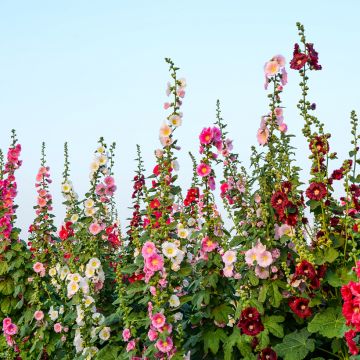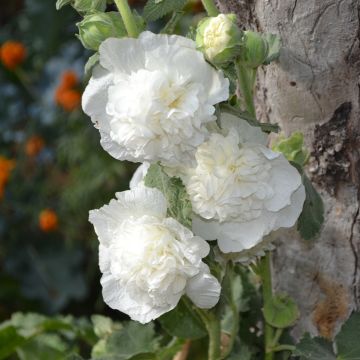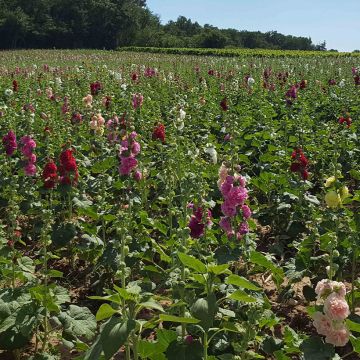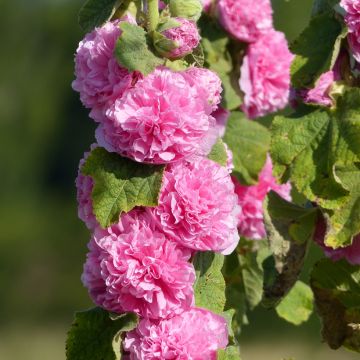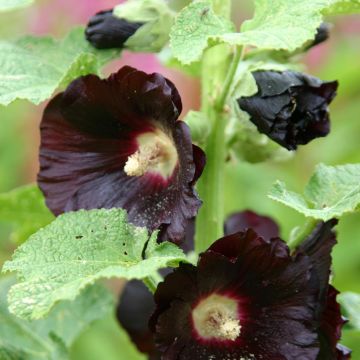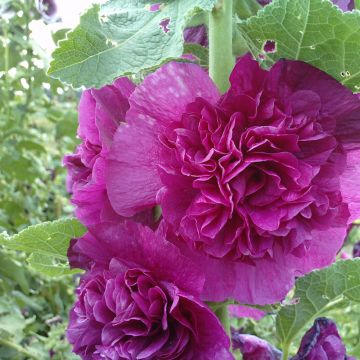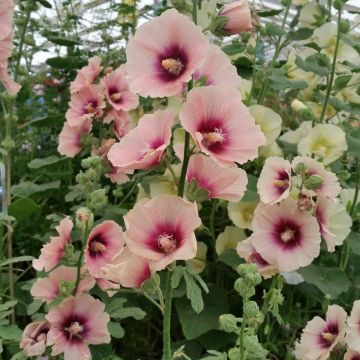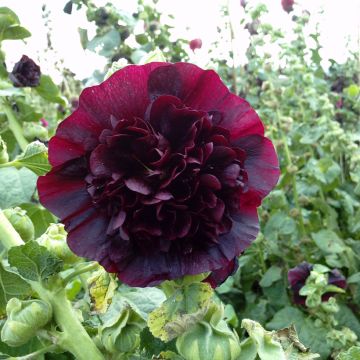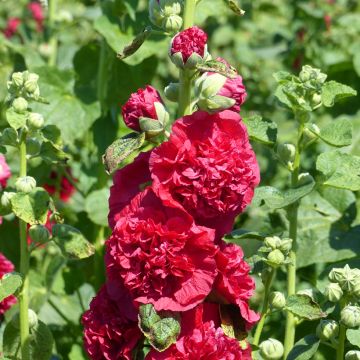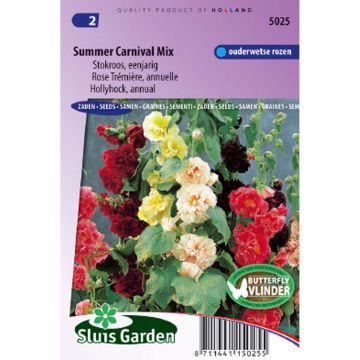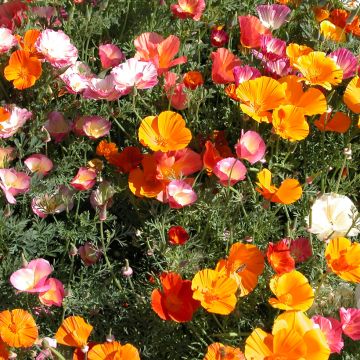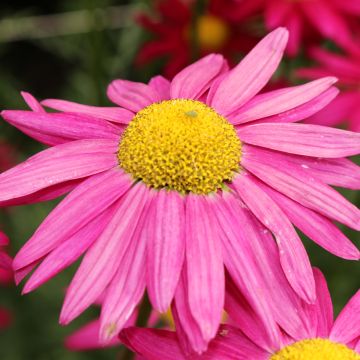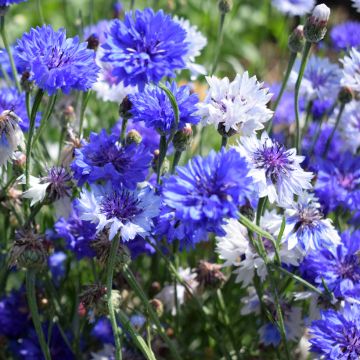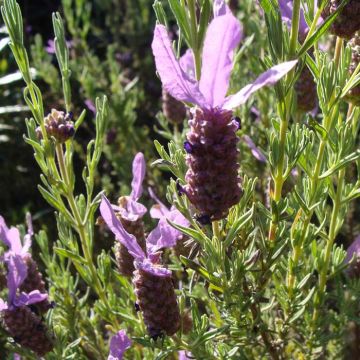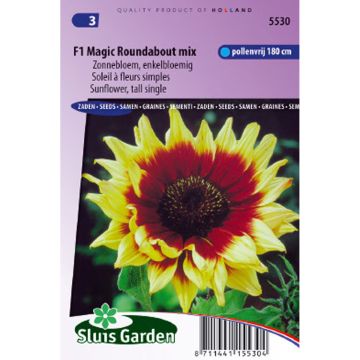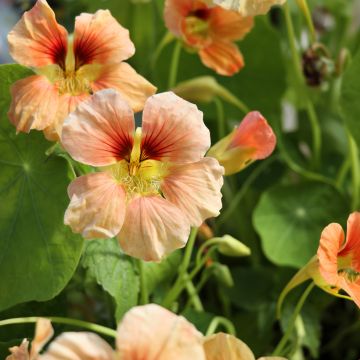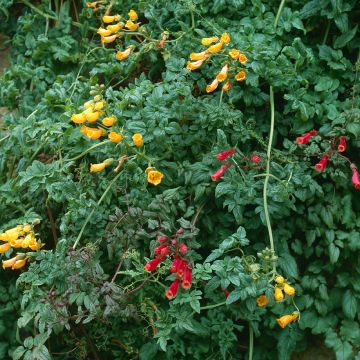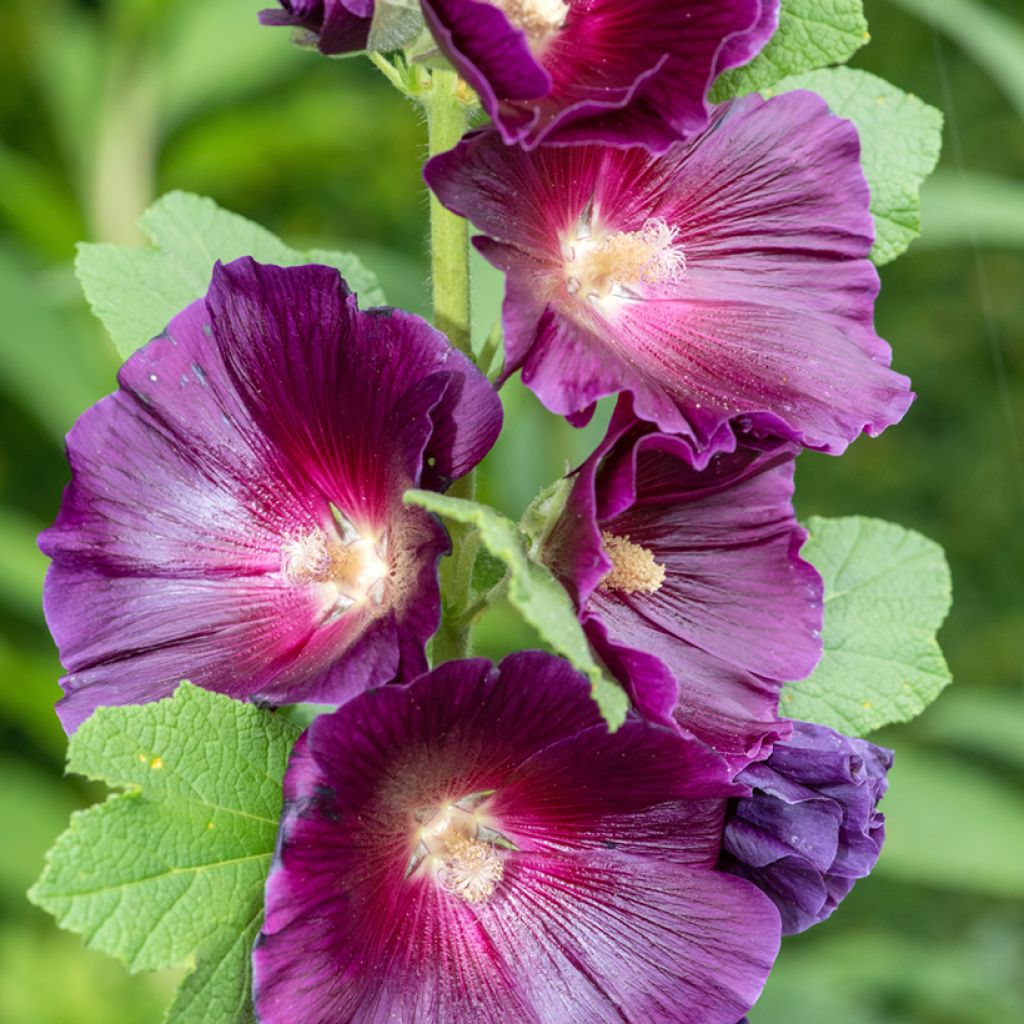

Alcea rosea Halo Lavender seeds - Hollyhock
Alcea rosea Halo Lavender seeds - Hollyhock
Alcea rosea Halo Lavender (Halo series)
Hollyhock
Why not try an alternative variety in stock?
View all →This plant carries a 6 months recovery warranty
More information
We guarantee the quality of our plants for a full growing cycle, and will replace at our expense any plant that fails to recover under normal climatic and planting conditions.
Seed-only orders are dispatched by sealed envelope. The delivery charge for seed-only orders is €3.90.
Does this plant fit my garden?
Set up your Plantfit profile →
Description
The Halo Lavender Hollyhock (Alcea rosea) is a variety from the 'Halo' series bearing single flowers in shades of purple with purple highlights, featuring a pink halo around a contrasting creamy yellow centre. Ideal for adding height to a garden, this perennial is perfect at the back of borders or in large flowerbeds. Its generous summer flowering feeds bees and butterflies. Hardy and less prone to rust, each plant produces 5 to 10 flowering stems after two years. It requires no watering once established and self-seeds spontaneously in the garden.
Alcea rosea, commonly known as hollyhock, belongs to the Malvaceae family and originates from the Middle East. The 'Halo' series, developed by breeder Thompson & Morgan in the early 2000s, stands out for its single flowers in vibrant colours, all marked by a contrasting centre. The 'Halo Lavender' cultivar presents large flowers measuring between 10 and 12 cm in diameter. Like other varieties in the series, this hollyhock can reach a height of 1.50 to 2 m depending on growing conditions. Its foliage is rough and dark green, and its sturdy flowering stems bring height to the garden. This very hardy variety can withstand temperatures down to -15°C, and it proves more perennial than most hollyhocks.
The other varieties in the 'Halo' series offer several colours to diversify flowerbeds. These include 'Halo White' (white flowers with yellow centre), 'Halo Red' (deep red with yellow centre), 'Halo Blush' (pale pink with darker centre), 'Halo Pink' (pink with yellow centre), 'Halo Apricot' (apricot with pink centre) and 'Halo Mixed' that brings them all together.
Halo Lavender Hollyhock adds height and elegance to a flowerbed when planted in the background or along a sunny wall. It pairs well with other tall perennials in shades of blue, white, pink, or purple. For instance, combine it with Veronicastrum virginicum 'Apollo' with its fine mauve floral spikes. Penstemon 'Husker Red', featuring white flowers and purple foliage, will provide a subtle contrast with the other two plants.
The hollyhock is both ornamental and medicinal. Its seeds yield an oil with astringent properties. Rich in mucilage, it has soothing, emollient, expectorant, laxative, and appetising properties that are weaker than those of its herbalist cousin, the marshmallow (Althea officinalis).
Report an error about the product description
Flowering
Foliage
Plant habit
Botanical data
Alcea
rosea
Halo Lavender (Halo series)
Malvaceae
Hollyhock
Cultivar or hybrid
Other Hollyhock seeds
Planting and care
Sow 'Halo Lavender' Hollyhocks from May to August. It takes 15 to 20 days for the young shoots to appear. Transplant the young plants, when they have reached a height of 7 cm, at a distance of 20 cm from each other. In the following spring, place them in your flower beds at a distance of 40 to 50 cm. Plan to stake them if the location is not sheltered from the wind. Avoid planting Hollyhocks in the same spot for several years in a row to prevent the appearance of rust (a parasitic fungus visible as orange powder) on the foliage. Hybrid hollyhocks, even though they tolerate summer drought and poor soils, are much more beautiful in fertile soil that retains some moisture in summer. They tolerate limestone very well. In heavy and wet winter soil, these plants will be more biennial than truly perennial. Under optimal growing conditions, they can live for 4 or 5 years.
Sowing period
Intended location
This item has not been reviewed yet - be the first to leave a review about it.
Flower seeds
Haven't found what you were looking for?
Hardiness is the lowest winter temperature a plant can endure without suffering serious damage or even dying. However, hardiness is affected by location (a sheltered area, such as a patio), protection (winter cover) and soil type (hardiness is improved by well-drained soil).

Photo Sharing Terms & Conditions
In order to encourage gardeners to interact and share their experiences, Promesse de fleurs offers various media enabling content to be uploaded onto its Site - in particular via the ‘Photo sharing’ module.
The User agrees to refrain from:
- Posting any content that is illegal, prejudicial, insulting, racist, inciteful to hatred, revisionist, contrary to public decency, that infringes on privacy or on the privacy rights of third parties, in particular the publicity rights of persons and goods, intellectual property rights, or the right to privacy.
- Submitting content on behalf of a third party;
- Impersonate the identity of a third party and/or publish any personal information about a third party;
In general, the User undertakes to refrain from any unethical behaviour.
All Content (in particular text, comments, files, images, photos, videos, creative works, etc.), which may be subject to property or intellectual property rights, image or other private rights, shall remain the property of the User, subject to the limited rights granted by the terms of the licence granted by Promesse de fleurs as stated below. Users are at liberty to publish or not to publish such Content on the Site, notably via the ‘Photo Sharing’ facility, and accept that this Content shall be made public and freely accessible, notably on the Internet.
Users further acknowledge, undertake to have ,and guarantee that they hold all necessary rights and permissions to publish such material on the Site, in particular with regard to the legislation in force pertaining to any privacy, property, intellectual property, image, or contractual rights, or rights of any other nature. By publishing such Content on the Site, Users acknowledge accepting full liability as publishers of the Content within the meaning of the law, and grant Promesse de fleurs, free of charge, an inclusive, worldwide licence for the said Content for the entire duration of its publication, including all reproduction, representation, up/downloading, displaying, performing, transmission, and storage rights.
Users also grant permission for their name to be linked to the Content and accept that this link may not always be made available.
By engaging in posting material, Users consent to their Content becoming automatically accessible on the Internet, in particular on other sites and/or blogs and/or web pages of the Promesse de fleurs site, including in particular social pages and the Promesse de fleurs catalogue.
Users may secure the removal of entrusted content free of charge by issuing a simple request via our contact form.
The flowering period indicated on our website applies to countries and regions located in USDA zone 8 (France, the United Kingdom, Ireland, the Netherlands, etc.)
It will vary according to where you live:
- In zones 9 to 10 (Italy, Spain, Greece, etc.), flowering will occur about 2 to 4 weeks earlier.
- In zones 6 to 7 (Germany, Poland, Slovenia, and lower mountainous regions), flowering will be delayed by 2 to 3 weeks.
- In zone 5 (Central Europe, Scandinavia), blooming will be delayed by 3 to 5 weeks.
In temperate climates, pruning of spring-flowering shrubs (forsythia, spireas, etc.) should be done just after flowering.
Pruning of summer-flowering shrubs (Indian Lilac, Perovskia, etc.) can be done in winter or spring.
In cold regions as well as with frost-sensitive plants, avoid pruning too early when severe frosts may still occur.
The planting period indicated on our website applies to countries and regions located in USDA zone 8 (France, United Kingdom, Ireland, Netherlands).
It will vary according to where you live:
- In Mediterranean zones (Marseille, Madrid, Milan, etc.), autumn and winter are the best planting periods.
- In continental zones (Strasbourg, Munich, Vienna, etc.), delay planting by 2 to 3 weeks in spring and bring it forward by 2 to 4 weeks in autumn.
- In mountainous regions (the Alps, Pyrenees, Carpathians, etc.), it is best to plant in late spring (May-June) or late summer (August-September).
The harvesting period indicated on our website applies to countries and regions in USDA zone 8 (France, England, Ireland, the Netherlands).
In colder areas (Scandinavia, Poland, Austria...) fruit and vegetable harvests are likely to be delayed by 3-4 weeks.
In warmer areas (Italy, Spain, Greece, etc.), harvesting will probably take place earlier, depending on weather conditions.
The sowing periods indicated on our website apply to countries and regions within USDA Zone 8 (France, UK, Ireland, Netherlands).
In colder areas (Scandinavia, Poland, Austria...), delay any outdoor sowing by 3-4 weeks, or sow under glass.
In warmer climes (Italy, Spain, Greece, etc.), bring outdoor sowing forward by a few weeks.

































